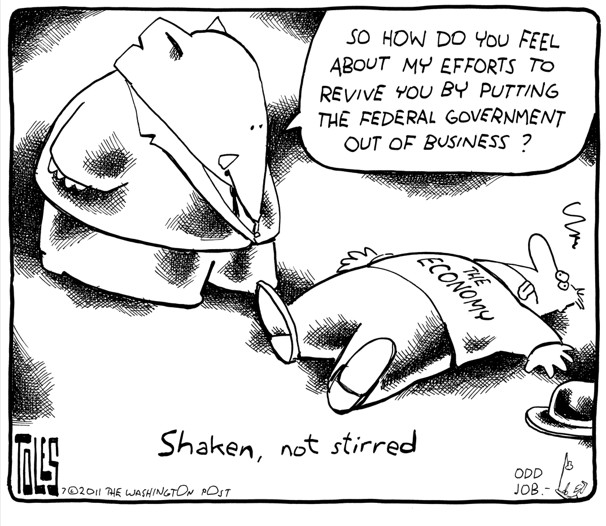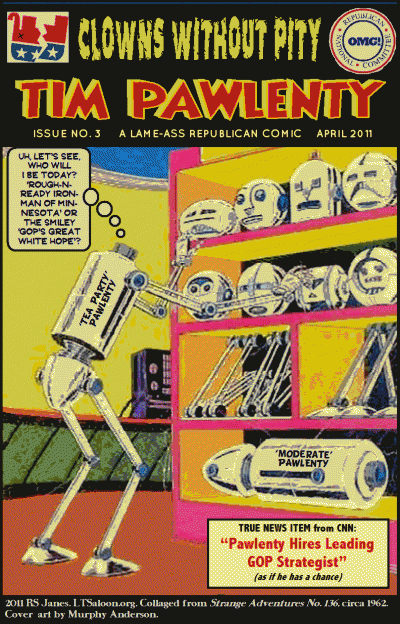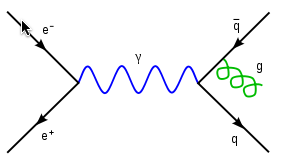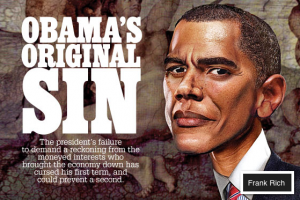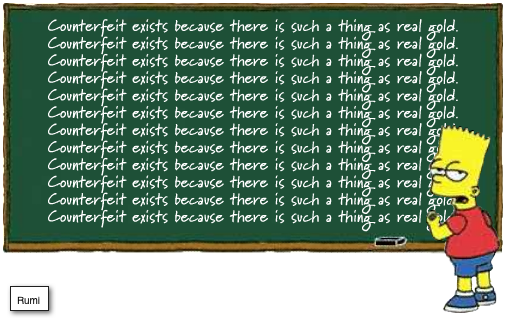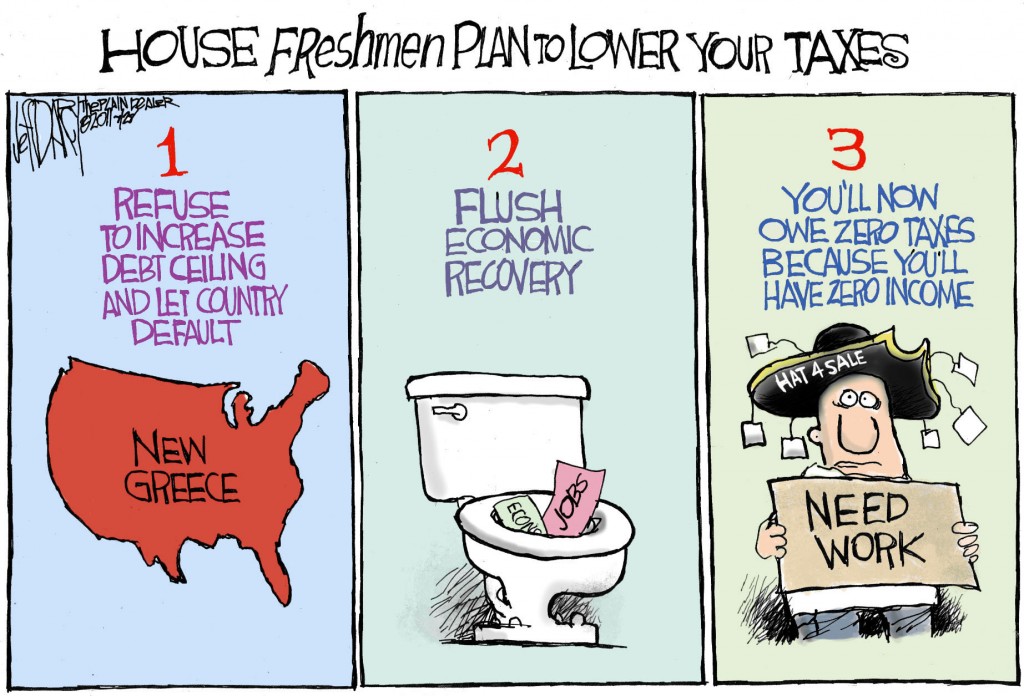
Monthly Archives: July 2011
Over the Cliff
Filed under current events, humor
Give Me the Soft Kind
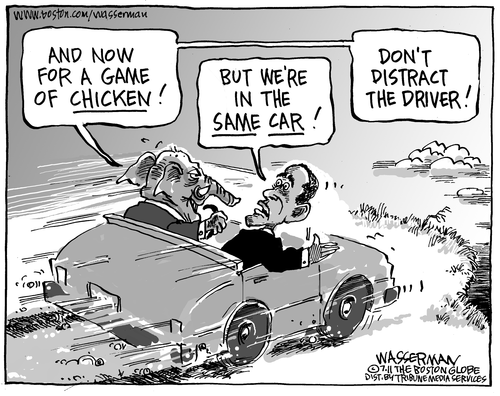
Their fiscal anarchism has now led to their threat to destabilize and possibly upend the American and global economy because they refuse to compromise an inch. They control only one part of the government, and yet they hold all of it hostage. I cannot believe they are prepared to allow the US to default rather than give an inch toward responsibility. Except I should believe it by now. Everything I have written about them leads inexorably to this moment. Opposing overwhelming public opinion on the need for a mixed package of tax hikes and spending cuts, drawing the president into a position far to the right of the right of his party, and posturing absurdly as fiscal conservatives, they are in fact anti-tax and anti-government fanatics, and this is their moment of maximal destruction. Andrew Sullivan The Daily Beast
Jobs? It seems to me the Republican jobs program is completely fused to a single agenda item, amplifying the concentration of wealth. End of story. I suppose the degree to go for is accounting.
In the world according to ALEC, [American Legislative Exchange Council] competing firms in free markets are the only real source of social efficiency and wealth. Government contributes nothing but security. Outside of this function, it should be demonized, starved or privatized. Any force in civil society, especially labor, that contests the right of business to grab all social surplus for itself, and to treat people like roadkill and the earth like a sewer, should be crushed. (ALEC Exposed, The Nation)
I’m quite confident none of the Republican candidates for President, including the likely nominee, Governor Rick Perry*, (at once one of our dumbest and most corrupt politicians,) would be able to coherently explain how our economy actually works. My confidence springs from knowing ahead of time that any such explanation would be fatally degraded from the git-go by ideology. (See sociologist Raymond Boudon, The Analysis of Ideology.)
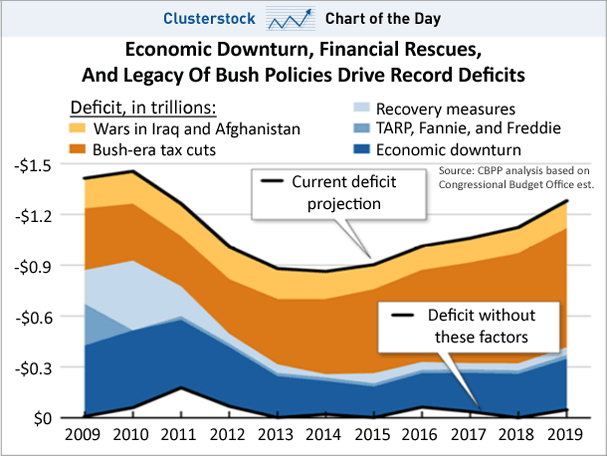
I’m also certain the Republican base nee Tea Party, would not end up enjoying the Randian utopia being planned out as a goal found beyond rolling back the AHCA, privatizing social security, vouchering Medicare, Medicaid, and education, eliminating: regulations, the EPA, and a bunch of other stuff, ending income, capital gains, and business taxes, installing a flat consumption tax. . .and that’s enough to send the economy totally over the edge.
I’m not sure the Republicans understand that they can be tossed out of office. Were these implemented, the various experiments can be reversed. I do get the Galtian move to eventually have to fiercely defend wealth, but voter ID won’t accomplish the task.
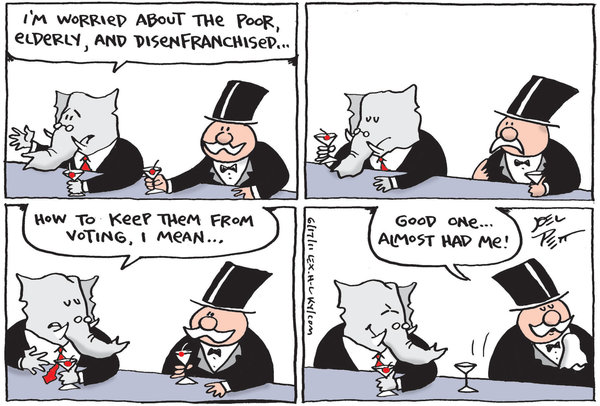
Our whole plutonomy thesis is based on the idea that the rich will keep getting richer. This thesis is not without its risks. For example, a policy error leading to asset deflation, would likely damage plutonomy. Furthermore, the rising wealth gap between the rich and poor will probably at some point lead to a political backlash. Whilst the rich are getting a greater share of the wealth, and the poor a lesser share, political enfrachisement remains as was – one person, one vote (in the plutonomies). At some point it is likely that labor will fight back against the rising profit share of the rich and there will be a political backlash against the rising wealth of the rich. This could be felt through higher taxation (on the rich or indirectly though higher corporate taxes/regulation) or through trying to protect indigenous laborers, in a push-back on globalization – either anti-immigration, or protectionism. We don’t see this happening yet, though there are signs of rising political tensions. However we are keeping a close eye on developments. Citigroup analyst note Revisiting Plutonomy: The Rich Getting Richer, March 5, 2006
The average daily insult to my intelligence is not a grievous injury, thanks to Stewart and Colbert.
I’m sure if I ever had the chance, and asked Barack Obama nicely, he’d be able to realistically explain the mechanic of how our economy actually works without blowing up his explanation with nutter propositions and moralist fantasies of the liberal sort. I think to myself: ‘lots of third order chops, so likely able to be reflective, candid, analytic and intelligent.’
Meanwhile, the current numerous spokespersons for the right-leaning fantasy, including the narrow continuum stretched right now between Cain and Romney, always seem to blow up their explanations in their first act of voicing “how it works.” No third order chops; heck Bachmann and Perry are following God’s voice(s) in their head!

One of the odd features of our politics is this: Romney likely has third order capabilities–in other words, he can think about how he thinks about thinking about something–but how would we ever find out for sure?
Here’s the planks of his economic competitiveness policy:
- Lower taxes on businesses to keep America competitive in the global economy
- Slash bureaucratic red tape and place a hard cap on the impact that federal regulations can have on the economy,
- Limit the corrosive influence of union bosses on productive businesses
In total, these suggests Mr. Romney is clueless. The last plank is arch and silly at the same time.
update – ooops. Fail.
Filed under current events
Glisssssssssendo
Final Soliloquy of the Interior Paramour
Light the first light of evening, as in a room
In which we rest and, for small reason, think
The world imagined is the ultimate good.
This is, therefore, the intensest rendezvous.
It is in that thought that we collect ourselves,
Out of all the indifferences, into one thing:
Within a single thing, a single shawl
Wrapped tightly round us, since we are poor, a warmth,
A light, a power, the miraculous influence.
Here, now, we forget each other and ourselves.
We feel the obscurity of an order, a whole,
A knowledge, that which arranged the rendezvous.
Within its vital boundary, in the mind.
We say God and the imagination are one…
How high that highest candle lights the dark.
Out of this same light, out of the central mind,
We make a dwelling in the evening air,
In which being there together is enough.
Wallace Stevens
Filed under Uncategorized
Attar: What Is Not the Mystic
Filed under sufism
Closer Than the Score

Counting me holding the camera, the Freeplay ‘ballers constituted two ten person teams Sunday. The game was closer than the final seven run margin on a scorching day. Integrated a couple of first timers, Mary bringing a ringer with her in her first appearance.
Filed under experiential learning
Transformative Anthropology. The Picture Inside
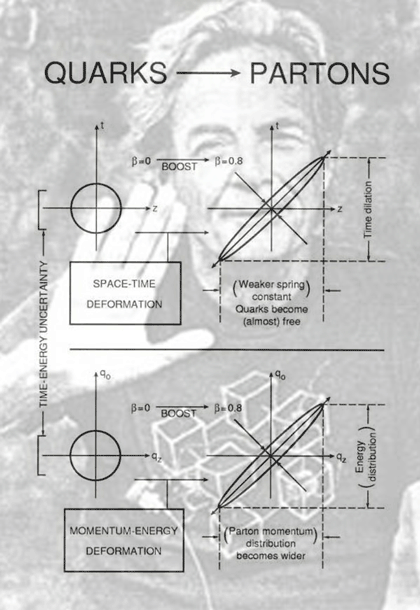
[…] Feynman visualized the world with pictures rather than with equations. Other physicists in the past and present describe the laws of nature with equations and then solve the equations to find out what happens. Feynman skipped the equations and wrote down the solutions directly, using his pictures as a guide. Skipping the equations was his greatest contribution to science. By skipping the equations, he created the language that a majority of modern physicists speak. Incidentally, he created a language that ordinary people without mathematical training can understand. To use the language to do quantitative calculations requires training, but untrained people can use it to describe qualitatively how nature behaves.
Feynman’s picture of the world starts from the idea that the world has two layers, a classical layer and a quantum layer. Classical means that things are ordinary. Quantum means that things are weird. We live in the classical layer. All the things that we can see and touch and measure, such as bricks and people and energies, are classical. We see them with classical devices such as eyes and cameras, and we measure them with classical instruments such as thermometers and clocks. The pictures that Feynman invented to describe the world are classical pictures of objects moving in the classical layer. Each picture represents a possible history of the classical layer. But the real world of atoms and particles is not classical. Atoms and particles appear in Feynman’s pictures as classical objects, but they actually obey quite different laws. They obey the quantum laws that Feynman showed us how to describe by using his pictures. The world of atoms belongs to the quantum layer, which we cannot touch directly.
The primary difference between the classical layer and the quantum layer is that the classical layer deals with facts and the quantum layer deals with probabilities. In situations where classical laws are valid, we can predict the future by observing the past. In situations where quantum laws are valid, we can observe the past but we cannot predict the future. In the quantum layer, events are unpredictable. The Feynman pictures only allow us to calculate the probabilities that various alternative futures may happen.
The quantum layer is related to the classical layer in two ways. First, the state of the quantum layer is what is called “a sum-over-histories,” that is, a combination of every possible history of the classical layer leading up to that state. Each possible classical history is given a quantum amplitude. The quantum amplitude, otherwise known as a wave function, is a number defining the contribution of that classical history to that quantum state. Second, the quantum amplitude is obtained from the picture of that classical history by following a simple set of rules. The rules are pictorial, translating the picture directly into a number. The difficult part of the calculation is to add up the sum-over-histories correctly. The great achievement of Feynman was to show that this sum-over-histories view of the quantum world reproduces all the known results of quantum theory, and allows an exact description of quantum processes in situations where earlier versions of quantum theory had broken down. The ‘Dramatic Picture’ of Richard Feynman New York Review of Books July 14, 2011 Freeman Dyson (reviewing Quantum Man: Richard Feynman’s Life in Science by Lawrence M. Krauss; Feynmana graphical biography by Jim Ottaviani
You see, when you ask why something happens, how does a person answer why something happens?
For example, Aunt Minnie is in the hospital. Why? Because she went out on the ice and slipped and broke her hip. That satisfies people. But it wouldn’t satisfy someone who came from another planet and knew nothing about things… When you explain a why, you have to be in some framework that you’ve allowed something to be true. Otherwise you’re perpetually asking why… You go deeper and deeper in various directions.
Why did she slip on the ice? Well, ice is slippery. Everybody knows that-no problem. But you ask why the ice is slippery… And then you’re involved with something, because there aren’t many things slippery as ice… A solid that’s so slippery?
Because it is in the case of ice that when you stand on it, they say, momentarily the pressure melts the ice a little bit so that you’ve got an instantaneous water surface on which you’re slipping. Why on ice and not on other things? Because water expands when it freezes. So the pressure tries to undo the expansion and melts it…
I’m not answering your question, but I’m telling you how difficult a why question is. You have to know what it is permitted to understand… and what it is you’re not.
You’ll notice in this example that the more I ask why, it gets interesting after a while. That’s my idea, that the deeper a thing is, the more interesting…(Richard Feynman. src: Kallos)
Why was she on the ice in the first place?
Eventually, in my consideration of the analytical frame for constitutive fortuity–eg. transformative anthropology–I’ll be fitting taxonomy to the richer, higher order conceptualization for eventuation. Eventuation means for this purpose the conjunction of events necessary to prime a fortuity. One of the intriguing and hard difficulties in wandering around the current mixture of term and operation is that the informal language used to denote folk conceptions about serendipity, fortuity, inter alia, are weighed down by all sorts of divergent connotations.
For example, Paul Lester describes in his book The Spiral Web a restaurant’s assembly of strangers being there all by coincidence.
OED travels from definition of coincidence, 1 to 4, like this:
1. a.1.a The fact or condition of being coincident; the occupation of the same place or part of space.
4.4 A notable concurrence of events or circumstances having no apparent causal connexion.
The strong connotation in every day use does attach notability, or, the exceptional, or another similar sense, and attaches also an underlying sense of there being no causal connection between two isolate and discretely caused events. This leads the meaning enough so that normal use in English-speaking cultures–for example: what a coincidence!–distinguished between the happenstance circumstance of being in a room full of strangers, and, encountering in this room a stranger, only to find enough of a commonality for the happenstance, to morph into notable coincidence.
However, as much as this leads to semantic, conceptual, and terminological conundrums, it is becoming increasingly clear that the causality that differently situates strangers so him or her come to occupy the same part of space may come to collapse together, as-it-were, in the conjunction given by a fortuitous event.
In which case, the folk phrase what a coincidence stands in for: these disparate events come to eventuate together in a single conjunctive event
This got me to thinking of both the metaphoric semblance, or, analogous collapse of histories. And of Dr. Feynman! With a kind of rubric, or top level category, constitutive fortuity, in hand, the sketching of a structural framework nears.
Something about the Feynman diagram compels me to play around with how elements of such a framework could be depicted.
Filed under my research
ARK: Survivor

S.Calhoun ARK Title: Survivor
ARK = appropriated random kitsch
Filed under visual experiments, my art
Photo-collage: Cosmos

click for lightbox enlargement
My concept here proofed, maybe even proved, was to patch together fireworks shots into a long range shot of a fantasy cosmos.
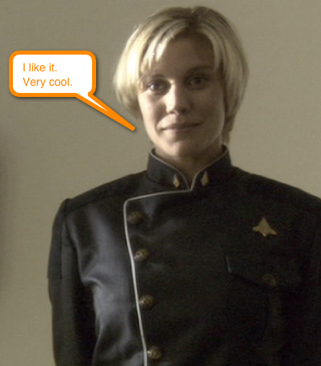
Filed under visual experiments, my art
Front Row Works
[flashvideo filename=http://www.squareone-learning.com/video/SH_FW-2011g.flv width=”512″ height=”288″ bufferlength=”30″ /]
(Canon PowerShot s95)
Later, after finishing the clip, I went through the stills.
Set the scene:



Then I had one of those intuitive ‘proof of concept ideas.’ I’ll roll it out tomorrow.
Filed under Cleveland



